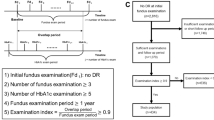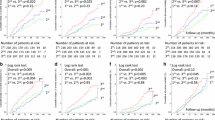Abstract
There is a growing debate in the literature on whether glucose variability contributes, as well as high HbA1c levels and longstanding diabetes, to the onset and progression of diabetic retinopathy (DR) in patients with diabetes types 1 (DM1) and 2 (DM2). Few data, obtained only by self-monitoring of blood glucose, support this hypothesis. We used continuous glucose monitoring (CGM) to investigate the association between DR and glucose variability parameters (SD, CONGA 2, MAGE), acute hyperglycemia (HBGI) and chronic exposure to glucose (AG and AUC tot). We studied 68 patients from 19 to 69 years old, 35 with DM1 and 33 with DM2. The prevalence of retinopathy was 43 % in DM 1 patients and 39 % in DM 2 patients. The values of all indicators were obtained by CGM for 72 h. DR was diagnosed on direct or indirect ophthalmoscopic examination, after inducing mydriasis with tropicamide. HbA1c was measured at the baseline and 6 weeks after CGM to test the stability of the patients’ glycemic control. Univariate analysis showed a close association between DR and duration of diabetes (OR 1.11; 1.04–1.19), intensive insulin therapy (OR 5.6, CI 1.14–27.30), SD (OR 1.03; CI 1.01–1.06) and CONGA 2 (OR 1.02; CI 1.00–1.04)—both indicators of variability and HBGI (OR 1.1, CI 1.01–1.18)—a parameter reflecting acute hyperglycemia. There was no significant correlation with HbA1c (p = 0.070). Multivariate regression analysis showed that disease duration is the parameter most significantly correlating with DR (OR 1.05; 1.01–1.15). These results reinforce the evidence that longstanding disease is the factor most closely associated with DR. Our data also suggest, however, that glucose variability—regardless of HbA1c—may also have a role as a risk factor for DR, particularly in the case of acute fluctuations (as represented by CONGA 2 and SD) and acute hyperglycemia (as represented by HBGI).
Similar content being viewed by others
References
Klein BE (2007) Overview of epidemiologic studies of diabetic retinopathy. Ophthalmic Epidemiol 14:179–183
Klein R (2008) Epidemiology of Diabetic Retinopathy. In Duh E (ed.) Diabetic Retinopathy
Cheung N, Mitchell P, Wong TY (2010) Diabetic retinopathy. Lancet 376:124–136
DCCT research group (1993) The effect of intensive treatment of diabetes on development and progression of long-term complications in insulin-dependent diabetes mellitus. N Eng J Med 329:977–986
UK Prospective Diabetes Study group (1998) Intensive blood-glucose control with sulphonylureas or insulin compared with conventional treatment and risk of complications in patients with type 2 diabetes. Lancet 352:837–853
Lachin JM, Genuth S, Nathan DM, Zinman B, Rutledge BN (2008) Effect of glycemic exposure on the risk of microvascular complications in the diabetes control and complications trial-revisited. Diabetes 57:995–1001
Giacco F, Brownlee M (2010) Oxidative stress and diabetic complications. Circ Res 107:1058–1070
Chang CM, Hsieh CJ, Huang JC, Huang IC (2012) Acute and chronic fluctuations in blood glucose levels can increase oxidative stress in type 2 diabetes mellitus. Acta Diabetol. doi:10.1007/s00592-012-0398-x
Nalysnyk L, Hernandez-Medina M, Krishnarajah G (2010) Glycaemic variability and complications in patients with diabetes mellitus: evidence from a systematic review of the literature. Diabetes Obes Metab 12:288–298
Siegelaar SE, Holleman F, Hoekstra JB, DeVries JH (2010) Glucose variability: does it matter? Endocr Rev 31:171–182
De Block C, Manuel-y-Keenoy B, Van Gaal L (2008) A review of current evidence with continuous glucose monitoring in patients with diabetes. J Diabetes Sci Technol 2:718–727
Hoekstra JB, Nathan DMJ, Borg R, Zheng H, Schoenfeld D, Heine RJ for the A1c-Derived Average Glucose (ADAG) Study Group (2008) Translating the A1C assay into estimated average glucose values. Diabetes Care 31:1473–1478
Sartore G, Chilelli NC, Burlina S, Stefano PD, Piarulli F, Fedele D, Mosca A, Lapolla A (2012) The importance of HbA1c and glucose variability in patients with type 1 and type 2 diabetes: outcome of continuous glucose monitoring (CGM). Acta Diabetol. doi:10.1007/s00592-012-0391-4
Klonoff DC (2005) Continuous glucose monitoring: roadmap for 21st century diabetes therapy. Diabetes Care 28:1231–1239
Ceriello A, Ihnat MA (2010) ‘Glycaemic variability’: a new therapeutic challenge in diabetes and the critical care setting. Diabet Med 27:862–867
Rodbard D (2009) New and improved methods to characterize glycemic variability using continuous glucose monitoring. Diabetes Technol Ther 11:551–565
Service FJ, Molnar GD, Rosevear JW, Ackerman E, Gatewood LC, Taylor WF (1970) Mean amplitude of glycemic excursions, a measure of diabetic instability. Diabetes 19:644–656
McDonnell CM, Donath SM, Vidmar SI, Werther GA, Cameron FJ (2005) A novel approach to continuous glucose analysis utilizing glycemic variation. Diabetes Technol Ther 7:253–263
Kovatchev BP, Cox DJ, Gonder-Frederick LA, Clarke W (2006) Evaluation of a new measure of blood glucose variability in diabetes. Diabetes Care 29:2433–2438
Early Treatment Diabetic Retinopathy Study Research Group (1991) Grading diabetic retinopathy from stereoscopic color fundus photographs—an extension of the modified Arlie house classification. ETDRS report number 10. Ophtalmology 98:786–806
Wilkinson CP, Ferris FL 3rd, Klein RE et al (2003) Proposed international clinical diabetic retinopathy and diabetic macular edema disease severity scales. Ophthalmology 110:1677–1682
Hammes HP, Kerner W, Hofer S, Kordonouri O, Raile K, Holl RW on behalf of the DPV–Wiss Study Group (2011) Diabetic retinopathy in type 1 diabetes—a contemporary analysis of 8,784 patients. Diabetologia 54:1977–1984
Kempen JH, O’ Colmain BJ, Leske MC et al (2004) The prevalence of diabetic retinopathy among adults in the United States. Arch Ophtalmol 122:552–563
Bolli GB, Andreoli AM, Lucidi P (2011) Optimizing the replacement of basal insulin in type 1 diabetes mellitus: no longer an elusive goal in the post-NPH era. Diabetes Technol Ther 13:S43–S52
Stolar M (2010) Glycemic control and complications in type 2 diabetes mellitus. The American Journal of Medicine 123:S3–S11
Kohnert KD, Augstein P, Zander E, Heinke P, Peterson K, Freise EJ et al (2009) Glycemic variability correlates strongly with postprandial β-cell dysfunction in a segment of type 2 diabetic patients using oral hypoglycemic agents. Diabetes Care 32:1058–1062
Lam CSY, Benzie IFF, Choi SW, Chan LYL, Yeung VTF, Woo GC (2011) Relationships among diabetic retinopathy, antioxidants, and glycemic control. Optom Vis Sci 88:251–256
Monnier L, Colette C, Owens D (2012) The glycemic triumvirate and diabetic complications: is the whole greater than the sum of its component parts? Diabetes Res Clin Pract 95:303–311
Kilpatrick ES, Rigby AS, Atkin SL (2009) Effect of glucose variability on the long-term risk of microvascular complications in type 1 diabetes. Diabetes Care 32:1901–1903
Zoppini G, Verlato G, Targer G et al (2008) Is fasting glucose variability a risk factor for retinopathy in people with type 2 diabetes? NMCD 19:334–339
Takao T, Ide T, Yanagisawa H, Kikuchi M, Kawazu S, Matsuyama Y (2011) The effects of fasting plasma glucose variability and time-dependent glycemic control on the long-term risk of retinopathy in type 2 diabetic patients. Diabetes Res Clin Pract 91:e40–e42
Patton SR, Midyett LK, Dolan LM, Powers SW (2011) A comparison of average daily risk range scores for young children with type 1 diabetes mellitus using continuous monitoring and self-monitoring data. Diabetes Technol Ther 14:239–243
Vazeou A (2011) Continuous blood glucose monitoring in diabetes treatment. Diabetes Res Clin Pract 93:S125–S130
Monnier L, Colette C, Owens DR (2008) Glycemic variability: the third component of the dysglycemia in diabetes. Is it important? How to measure it? J Diabetes Sci Technol 2:1094–1100
Ceriello A, Ihnat MA, Thorpe JE (2009) Clinical review 2: the “metabolic memory”: is more than just tight glucose control necessary to prevent diabetic complications? J Clin Endocrinol Metab 94:410–415
Conflict of interest
None.
Author information
Authors and Affiliations
Corresponding author
Additional information
Communicated by Massimo Federici.
Rights and permissions
About this article
Cite this article
Sartore, G., Chilelli, N.C., Burlina, S. et al. Association between glucose variability as assessed by continuous glucose monitoring (CGM) and diabetic retinopathy in type 1 and type 2 diabetes. Acta Diabetol 50, 437–442 (2013). https://doi.org/10.1007/s00592-013-0459-9
Received:
Accepted:
Published:
Issue Date:
DOI: https://doi.org/10.1007/s00592-013-0459-9




